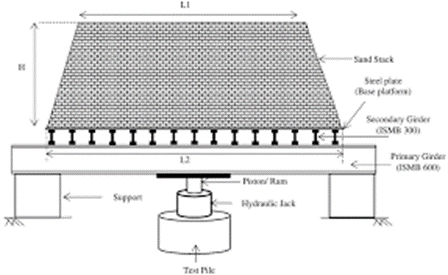Static Vertical Pile Load

STATIC VERTICAL PILE LOAD TEST AS PER IS 2911 PART-4 2013
Static Load Tests are used to measure the way in which a pile behaves under an applied load. A static, constant load (increasing in steps) is applied to the pile slowly and at a low strain and the displacement is measured.
The primary purpose of this testing was to check whether the estimated design pile capacity is available or not, in the pile installed at the site.
In this type of Test, Compression (Vertical downward) load is applied to the pile top by means of hydraulic jack against rolled steel joist or suitable load frame with adequate Kentledge and settlement is recorded by suitable positioned dial gauges/ LVDTs.
Kentledge Method
The Kentledge method for pile load testing involves applying a load to a pile using a grillage system and kentledge (heavy concrete blocks) to measure the pile’s settlement and bearing capacity. This method is a traditional way to assess the structural integrity of piles before construction.
Here’s a more detailed breakdown:

Step 1: Preparation
- Pile Installation: The test pile is installed at the desired location.
- Reacting System: A grillage system, often supported by reaction piles or anchors, is constructed to withstand the load.
- Kentledge Placement: Kentledge blocks (heavy concrete blocks) are placed on top of the grillage to apply the load.
Step 2: Loading and Measurement
- Incremental Loading: Load is applied incrementally, usually in 20% increments of the safe load of the pile, as described in the IS code.
- Settlement Measurement: Dial gauges or strain gauges are used to monitor the pile's settlement at each load increment.
- Load Duration: Each load increment is maintained for a specified period, often until the pile's settlement rate is very small (e.g., 0.2 mm/hour) or for a set time (e.g., 2 hours).
- Data Recording: Settlement observations are recorded in a tabular format.
Step 3: Data Analysis
- Load-Settlement Curve: The collected data is plotted to create a load-settlement curve, which helps determine the pile's bearing capacity and settlement characteristics.
- Safe Load Determination: The safe load is determined based on the load-settlement curve and established guidelines.
Advantages of the Anchor Method
- Simplicity: The methodology is straightforward and easy to understand.
- Direct Measurement: Provides direct measurements of pile capacity and settlement behavior.
- Established Method: Long history of use in geotechnical engineering, with extensive data available for comparison.
